Tyrone Power
| Tyrone Power | |
|---|---|
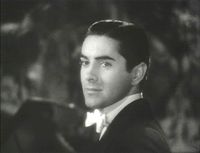 in Alexander's Ragtime Band (1938) |
|
| Born | Tyrone Edmund Power, Jr. May 5, 1914 , U.S. |
| Died | November 15, 1958 (aged 44) Madrid, Spain |
| Occupation | Actor |
| Years active | 1932–1958 |
| Spouse | Annabella (1939–1948) (divorced) Linda Christian (1949–1956) (divorced) 2 children Debbie Ann Minardos (1958–1958) (his death) 1 child |
Tyrone Edmund Power, Jr. (May 5, 1914 – November 15, 1958), usually credited as Tyrone Power and known sometimes as Ty Power, was an American film and stage actor who appeared in dozens of films from the 1930s to the 1950s, often in swashbuckler roles or romantic leads such as in The Mark of Zorro, Blood and Sand, The Black Swan, Prince of Foxes, The Black Rose, and Captain from Castile.
Though renowned for his dark, classically handsome looks that made him a matinee idol from his first film appearance, Power played a wide range of roles, from film noir to light romantic comedy. In the 1950s, he began placing limits on the number of movies he would make in order to have time for the stage. He received his biggest accolades as a stage actor in John Brown's Body and Mister Roberts. Power died from a heart attack at the age of 44.
Contents |
Early life
Born in Cincinnati, Ohio, in 1914, the only son of the English-born American stage and screen actor Tyrone Power, Sr., and Helen Emma "Patia" Reaume, Power was descended from a long theatrical line going back to his great-grandfather, the Irish-born actor and comedian Tyrone Power (1795-1841). He had French blood from both his parents, being descended from Catholic French Canadians through his mother's Reaume family, and from Protestant Huguenots through his paternal grandmother's Lavenu and Blossett ancestors.[1] Through his paternal great grandmother, Anne Gilbert, Power was related to the actor Lord Laurence Olivier; through his paternal grandmother, Ethel Lavenu, he was related by marriage to author Evelyn Waugh and through his father's first cousin, Norah Emily Gorman Power, he was related to the theatrical director Sir (William) Tyrone Guthrie, founder of the Stratford Theatre in Canada and the Tyrone Guthrie Theatre in Minneapolis, Minnesota.[2]
During the first year of Power's life, he lived in Cincinnati. His father was absent for long periods due to his stage commitments in New York. Young Power was a sickly child, and his doctor advised his family that the climate in California might be better for his health. The family moved there in 1915, and Power's sister Anne was born there on August 26, 1915. The parents appeared together on stage and, in 1917, their movie, The Planter, was released. Tyrone Power, Sr., as he later became known, found himself away from home more frequently, as his stage career took him to New York. The Powers drifted apart, and they divorced around 1920.
After the divorce, Patia Power worked as a stage actress. In 1921, at the age of 7, young Tyrone appeared with his mother in the mission play, La Golondrina, at San Gabriel, California. A couple of years later the family moved back to Cincinnati, where they lived with the family of Patia's aunt, Helen Schuster Martin, founder of the Schuster-Martin School of Drama. Power's mother supported her family as a drama and voice coach at the Schuster-Martin School. For several years she coached her son in voice and dramatics during her spare time. Power grew up in the Martin household with his two cousins, Roberta and William [Bill], his mother's aunt Helen and her husband, William Martin's children. Power went to Cincinnati-area Catholic schools and graduated from Purcell High School in 1931. Upon his graduation, he opted to join his father to learn what he could about acting from one of the stage's most respected actors.
Career
1930s
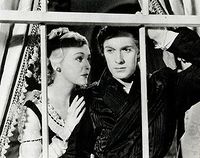
Tyrone Power joined his father for the summer of 1931, after being separated from him for some years due to his parents' divorce. His father suffered a heart attack in December 1931, dying in his son's arms, while preparing to perform in The Miracle Man. Tyrone Power, Jr., as he was then known, decided to continue his pursuit of an acting career. He went door to door, trying to get work as an actor, and, while many contacts knew his father well, they offered praise for his father but no work for him. He appeared in a bit part in 1932 in Tom Brown of Culver, a movie starring actor Tom Brown. Power's experience in that movie didn’t open any other doors, however, and, except for what amounted to little more than a job as an extra in Flirtation Walk, he found himself frozen out of the movies but making some appearances in community theater. Discouraged, he took the advice of friend, Arthur Caesar, to go to New York to get experience as a stage actor.
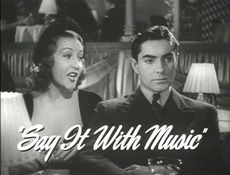
Along the way, he stopped in Chicago, where his friend, Don Ameche, a radio personality, convinced him to stay awhile to work in radio. He wasn’t able to get a foothold in radio, however, and he eventually went on to New York. There, he met Katharine Cornell, the great stage actress, who cast him as an understudy for Burgess Meredith, for the play, Flowers of the Forest. A better stage break came, though, when Cornell put him in the role of Benvolio in Romeo and Juliet. During this time, Hollywood scouts saw him and offered him a screen test. Katharine Cornell advised against going to Hollywood, without a little more stage experience, and Tyrone Power took her advice. Cornell gave him a substantial role in her next stage play, St. Joan. Once again, Hollywood scouts saw him and offered him a screen test. Cornell told him that he was ready.
Tyrone Power went to Hollywood in 1936, where he was signed by 20th Century-Fox. He would be their top leading man for years to come. He got a false start at 20th Century-Fox, though, when he was assigned to Sing Baby Sing, at the request of Alice Faye, already a star for the studio. The director, Sidney Lanfield, didn’t recognize his potential and removed him from the cast, telling him that he should find another line of work, as he would never become an actor. Faye intervened again on his behalf, and she convinced the studio to give him another chance. He was assigned to a small part in Girls' Dormitory. In this movie, he caught the eye of many fans, among them Hedda Hopper, who stayed for a second showing to find out who the young man was with just a few lines at the end of the movie. Following that, he was cast in a slightly larger part in Ladies in Love, which starred Janet Gaynor, Constance Bennett, and Loretta Young. It looked as though 20th Century-Fox was not going to pick up his option, however, and Tyrone Power then went to the office of director Henry King to ask him to consider him for a role. King was impressed with his looks and poise, and he insisted that Tyrone Power be tested for the lead role in Lloyd's of London, a role thought to already belong to Don Ameche. Despite Darryl F. Zanuck's reservations, he decided to go ahead and give him the lead role in the movie, once Henry King and Fox editor, Barbara McLean, convinced him that Power had a greater screen presence than did Don Ameche. He was fourth billed in the movie, but he had by far the most screen time of any actor. He walked into the premiere of the movie an unknown, and he walked out a star, which he stayed for the remainder of his career.
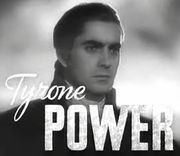

Tyrone Power racked up hit after hit from 1936 until 1943, when his career was interrupted for military service. In these years, he starred in romantic comedies such as Thin Ice and Day-Time Wife; in dramas such as Suez, Blood and Sand, Son of Fury: The Story of Benjamin Blake,The Rains Came, and In Old Chicago; in the musicals, Alexander's Ragtime Band, Second Fiddle, and Rose of Washington Square; in the westerns, Jesse James (1939) and Brigham Young; in the war films, Yank in the R.A.F. and This Above All; and, of course, the swashbucklers, The Mark of Zorro and The Black Swan. Jesse James was a very big hit at the box office, but it did receive some criticism for fictionalizing and glamorizing the famous outlaw. The movie was shot in and around the Pineville, Missouri area and was Power's first location shoot and his first Technicolor movie. Before his career was over, he would have filmed a total of 16 movies in color, including the movie he was filming when he died. He was loaned out once, for MGM for 1938's Marie Antoinette. Darryl F. Zanuck was angry that MGM used Fox's biggest star in what was, despite billing, a supporting role, and he vowed to never again loan him out. Though Power's services were requested for the role of Ashley Wilkes in Gone with the Wind, Joe Bonaparte in Golden Boy,[3] Paris in King's Row, by Harry Cohn for several films throughout the years,[4] and by Norma Shearer herself for her planned production of The Last Tycoon to play Irving Thalberg,[5] Zanuck stuck by his original decision.
He was named the second biggest box office draw in 1939, only surpassed by Mickey Rooney.[6]
1940s
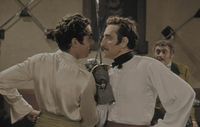
In 1940 the direction of Tyrone Power's career took a dramatic turn when his movie, The Mark of Zorro, was released. Power played the role of Don Diego Vega, fop by day, and Zorro, bandit hero by night. The role had been made famous by Douglas Fairbanks in the 1920 movie by the same title. Power's performance was excellent, and 20th Century Fox often cast him in swashbucklers in the years that followed. Power was actually a superb swordsman, and the dueling scene in The Mark of Zorro is considered one of the finest in screen history. The great Hollywood swordsman, Basil Rathbone, who starred with him in The Mark of Zorro, commented, "Power was the most agile man with a sword I’ve ever faced before a camera. Tyrone could have fenced Errol Flynn into a cocked hat."
Despite being kept busy making movies at 20th Century-Fox, Tyrone Power found time to do radio and stage work. He appeared with his wife, Annabella, in several radio broadcasts, including the plays Blood and Sand, The Rage of Manhattan, and Seventh Heaven. He also appeared with her in the stage play, Liliom, in Country Playhouse, Westport, Connecticut, in 1941. He worked with other big names, in radio. Among those he starred with were Humphrey Bogart, Jeanne Crain, Loretta Young, Alice Faye, and Al Jolson.
Tyrone Power's career was interrupted in 1943 by military service. He reported to the U.S. Marines for training in late 1942, but he was sent back, at the request of 20th Century-Fox, to complete one more film, 1943's Crash Dive, a patriotic war movie. He was credited in the movie as Tyrone Power, U.S.M.C.R., and the movie served as much as anything as a recruiting film. Anne Baxter would become a leading lady of his, both on the screen and on stage. Other than re-releases of his films, he wasn’t seen on screen again until 1946, when he co-starred with Gene Tierney in The Razor's Edge, an adaptation of W. Somerset Maugham's novel of the same name.
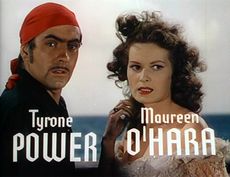
Next up for release was a movie that Tyrone Power had to fight hard to make – the film noir, Nightmare Alley. Darryl F. Zanuck was reluctant to allow Power to make the movie; his handsome appearance and charming manner had been a marketable asset to the studio and Zanuck feared that the dark role might hurt Power's image. Zanuck eventually agreed, giving him A-list production values for what normally would be a B film. The movie was directed by Edmund Goulding, and, though the film died at the box office (Zanuck did not publicize it and removed it from release), Power received some of the best reviews of his career. The film was released on DVD in 2005 after years of legal battles, and Power once again received favorable reviews from 21st century critics.
Power's venture into gritty drama was short lived, as he was next seen in a costume movie, Captain from Castile, directed by Henry King, who directed Tyrone Power in eleven movies. After making a couple of light romantic comedies, That Wonderful Urge (with Gene Tierney, his co-star from The Razor's Edge) and The Luck of the Irish (with Anne Baxter), Power found himself once again in swashbucklers – The Black Rose and Prince of Foxes.
1950s
As the 1950s rolled around, Power was becoming increasingly unhappy with his movie assignments, with such movies as American Guerrilla in the Philippines and Pony Soldier, so in 1950 he traveled to England to play the title role in Mister Roberts to sellout crowds, for twenty-three weeks, at the London Coliseum.
His movies had been very profitable for Fox and, as an enticement to renew his contract, they offered him the lead role in The Robe. He turned it down (the job ultimately went to Richard Burton) and, on 1 November 1952, left on a ten week national tour with John Brown's Body, a three-person dramatic reading of Stephen Vincent Benét's narrative poem, adapted and directed by Charles Laughton, and featuring Power, Judith Anderson and Raymond Massey; which culminated in a run of 65 shows between February and April 1953 at the New Century Theater on Broadway.
His studio had granted him permission to seek his own roles outside 20th Century-Fox, with the understanding that he would fulfill his fourteen-film commitment to them in between his other projects. In 1953 he made The Mississippi Gambler for Universal Studios, negotiating a deal entitling him to a percentage of the profits, and earned a million dollars from the movie.
The critics had applauded his performances in "John Brown's Body" earlier in the year, a second national tour with the show followed in October 1953, this time for four months, with Raymond Massey and Anne Baxter.
In 1953, actress and producer Katharine Cornell cast Power as her love interest in The Dark is Light Enough (play), a verse drama by British dramatist Christopher Fry. The play was set in Austria in 1848. Between November, 1954 and April, 1955 he toured in that role in the USA and Canada ending with 12 weeks at the Anta Theater, New York and two weeks at the Colonial Theater, Boston. His performance in Julian Claman's A Quiet Place, staged at the National Theater, Washington, at the end of 1955 was warmly received by the critics.
Untamed, Tyrone Power's last movie made under his contract with 20th Century-Fox, was released in 1955, and same year saw the release of The Long Gray Line, a successful John Ford film for Columbia Pictures.
In 1956, the year Columbia released The Eddy Duchin Story, another great success for the star, he returned to England to play the rake, Dick Dudgeon, in a revival of Shaw's The Devil's Disciple for one week at the Opera House in Manchester and nineteen weeks at the Winter Garden, London.

His old boss, Darryl F. Zanuck, persuaded him to play the lead role in The Sun Also Rises (1957), adapted from the Hemingway novel. Released that same year were Abandon Ship and John Ford's Rising of the Moon (narrator only). Tyrone Power's last film role turned out to be one of his most highly regarded, cast against type as the accused murderer, Leonard Vole, in Agatha Christie's Witness for the Prosecution, directed by Billy Wilder. The critic for The National Post, Robert Fulford, commented on the "superb performance" of Power as "the seedy, stop-at-nothing exploiter of women"[7] which was in sharp contrast to his earlier swashbuckling roles and romantic heroes. The movie was well received and a success at the box office.
Power returned to the stage in March, 1958 to play the lead in Arnold Moss's adaptation of Shaw's 1921 play, Back to Methuselah. In September 1958, Tyrone Power went to Madrid and Valdespartera, Spain, to film the epic, Solomon and Sheba, to be directed by King Vidor. He had filmed about 75 per cent of his scenes when he was stricken with a massive heart attack, as he was filming a dueling scene with his frequent co-star and friend, George Sanders. He died en route to the hospital. Yul Brynner was brought in to take over the role of Solomon. The filmmakers used some of the long shots that Tyrone Power had filmed, and an observant fan can see him in some of the scenes, particularly in the middle of the duel.
Tyrone Power's last movie, fittingly, was to be in a familiar role, with sword in hand. He is perhaps best remembered as a swashbuckler, and, indeed, he was one of the finest swordsmen in Hollywood. Director Henry King said, "People always seem to remember Ty with sword in hand, although he once told me he wanted to be a character actor. He actually was quite good – among the best swordsmen in films."
Personal life
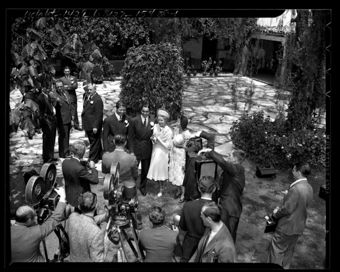
Tyrone Power was one of Hollywood's most eligible bachelors when he married French actress, Annabella (born Suzanne Georgette Charpentier) on April 23, 1939. They met on the 20th Century-Fox lot, around the time they starred together in the movie Suez. Annabella was a big star in France when 20th Century-Fox brought her over to America, and she was given the big buildup as the next great French star for Hollywood pictures. When Darryl F. Zanuck, 20th Century-Fox studio boss, realized the seriousness of the romance between her and his top male star, however, he strongly objected, fearing that Power would lose part of his female fan base if he were married. Zanuck offered to give Annabella plum roles in movies to be filmed abroad, in order to get her out of the country and away from one of Hollywood's biggest heartthrobs. When Power and Annabella went against Zanuck's wishes and married, Annabella's career at 20th Century Fox suffered greatly. After the marriage, Zanuck refused to assign her to movies for the studio, in punishment for their disobedience. After her marriage, she had to wait until after Tyrone Power had left the studio for military service to make another movie. This lack of movie work caused the very talented actress to seek stage work in order to help satisfy her desire to act. In an A&E biography, Annabella said that Zanuck "could not stop Tyrone's love for me, or my love for Tyrone." Their marriage, by all accounts at the time, was a happy one for the first couple of years, but it was on rocky ground by the time Tyrone left for the U.S. Marines in 1943.
His extramarital affair with Judy Garland is said to have contributed to the failure of their marriage. However, those close to the couple say that there were also other reasons for the marriage failure. J. Watson Webb, close friend and an editor at 20th Century Fox, maintained, in the A&E Biography, that one of the reasons the marriage fell apart was the inability of Annabella to give him a child. He said that there was no bitterness between the couple. In a March 1947 issue of Photoplay, Power was interviewed and said that he wanted a home and children. Annabella shed some light on the situation in an interview that she did for Movieland magazine in 1948. She said, "Our troubles began because the war started earlier for me, a French-born woman, than it did for Americans." She explained that the war clouds over Europe made her unhappy and irritable and, to get her mind off her troubles, she began accepting stage work, which often took her away from home, for weeks, or in one case, months at a time. "It is always difficult to put one's finger exactly on the place and time where a marriage starts to break up," she said. "But I think it began then. We were terribly sad about it, both of us, but we knew we were drifting apart. I didn’t think then - and I don’t think now - that it was his fault, or mine." The couple tried to make their marriage work when Power returned from military service, but they were unable to do so. Annabella claimed that he had changed too much during the war. They were legally separated in the fall of 1946 and divorced a couple of years later. Despite the divorce, they remained close until his death.
Following his separation from Annabella, Power entered into a love affair with Lana Turner which lasted for a couple of years. In the fall of 1948, however, he went on a good-will trip to Europe and South Africa. On that trip, he saw and fell in love with Linda Christian, in Rome. Upon his return to the U.S., he broke the news to Lana Turner that their romance was over. In her autobiography, Turner said that MGM, her home studio, and 20th Century Fox, Power's studio, conspired to break up their romance. Each studio feared that they would lose their star to the other studio, if they were to marry. Turner claimed that, when Power made his goodwill trip to Europe and South Africa, the story of her dining out with Frank Sinatra, a friend, was leaked to Power, who became very upset with her "dating" another man, in his absence. Turner also claimed that there was just too much coincidence in Linda Christian's being at the same hotel as Tyrone Power, and she implied that Christian had obtained Power's itinerary from 20th Century Fox.
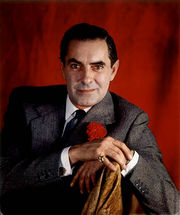
Power and Christian were married on January 27, 1949, in the Church of Santa Francesca, with an estimated 8,000 – 10,000 screaming fans outside the church. Christian miscarried three times before finally giving birth to a baby girl, Romina Francesca Power, on October 2, 1951. A second daughter, Taryn Stephanie Power, was born September 13, 1953. Around the time of Taryn's birth, the Power marriage was rocky. In her autobiography, Christian blamed the breakup of her marriage on her husband's extramarital affairs. However, she acknowledged that she had an affair with Edmund Purdom, which created great tension between Christian and her husband. They divorced in 1955.[8]
After his divorce from Christian, Power had a long-lasting love affair with Mai Zetterling,[9] whom he had met on the set of Abandon Ship. At this point in time, however, he vowed that he would never marry again, because he had been twice burned financially from his previous marriages. He also entered into an affair with a British actress, Thelma Ruby.[10] In 1957, however, he met Deborah Ann Montgomery Minardos. They were married on May 7, 1958, and she became pregnant soon after. She accompanied her husband to Madrid in September 1958, for the filming of Solomon and Sheba. She was worried about his health and asked him to slow down, but he pushed ahead with the movie. On November 15, 1958, while filming a strenuous dueling scene for the movie, he had a heart attack and died. His wife gave birth to his son, Tyrone Power IV, on January 22, 1959.
Military service
In August 1942, he enlisted in the Marine Corps. He attended boot camp at Marine Corps Recruit Depot San Diego and then attended Officer's Candidate School at Marine Corps Base Quantico, where he was commissioned a Second Lieutenant on June 2, 1943. Because he had already logged 180 solo hours as a pilot prior to enlisting in the Marine Corps, Tyrone Power was able to go through a short, intense flight training program at Naval Air Station Corpus Christi, Texas, where he earned his wings and was promoted to First Lieutenant. Power arrived at Marine Corps Air Station Cherry Point, North Carolina in July, 1944 and was assigned to VMR-352 as an R5C transport copilot. The squadron moved to Marine Corps Air Station El Toro in California in October 1944. Power was reassigned to VMR-353 and joined them on Kwajalein in February 1945. He flew cargo and wounded Marines during the Battle of Iwo Jima and the Battle of Okinawa. He returned to the United States in November 1945 and he was released from active duty in January 1946. He was promoted to Captain in the reserves on May 8, 1951 but was not recalled for service in the Korean War.[11]
In the June 2001 Marine Air Transporter newsletter, Jerry Taylor, a retired Marine Corps flight instructor, recalls memories of World War II. He speaks of training Tyrone Power as a pilot, saying, "He was an excellent student, never forgot a procedure I showed him or anything I told him." Others who served with him have commented that he was well-respected by those with whom he served.[12]
Honors
Tyrone Power was honored with having his handprints and footprints put in cement at Grauman's Chinese Theater on May 31, 1937. He was honored in a joint ceremony with Loretta Young, on the occasion of the premiere of their movie Cafe Metropole. At the time of the ceremony, Tyrone was just 23 years old and had been a major star for only six months. He signed the cement block, "To Sid - Following in my father's footsteps", which was a tribute to his father, stage and film star Tyrone Power, Sr.
Tyrone Power's star on the Hollywood Walk of Fame can be found at 6747 Hollywood Blvd.
Epilogue
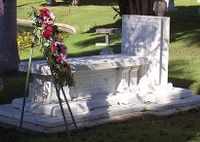
Tyrone Power was buried at Hollywood Cemetery, now known as Hollywood Forever Cemetery, Hollywood, California, at noon, on November 21, 1958, in a military service. The memorial service was held at the Chapel of the Psalms, Hollywood Cemetery, with Chaplain Thomas M. Gibson, U.S.N.R. officiating. The active pallbearers were officers of the United States Marine Corps. Honorary pallbearers were Charles Laughton, Raymond Massey, Tommy Noonan, Theodore Richmond, Murray Steckler, Cesar Romero, Watson Webb, Milton Bren, James Denton, George Sidney, George Cohen, Lew Schreiber, Lew Wasserman, and Harry Brand. Cesar Romero gave the eulogy, using in it a tribute written by Tyrone Power's good friend and frequent co-star, George Sanders. Sanders had written the tribute on the set of Solomon and Sheba, within the first few hours after Power's death. It read as follows:
I shall always remember Tyrone as a bountiful man, a man who gave freely of himself. It mattered not to whom he gave. His concern was in the giving. I shall always remember his wonderful smile, a smile that would light up the darkest hour of the day, like a sunburst. I shall always remember Tyrone Power as a man who gave more of himself than it was wise for him to give, until in the end, he gave his life.
Flying over the service was Henry King, who directed him in eleven movies. Almost 20 years before, Tyrone had flown with King, in King's plane, to the set of Jesse James in Missouri. It was then that Tyrone Power got his first experience with flying, which would become such a big part of his life, both in the U.S. Marines and in his private life. In the foreword to Dennis Belafonte's The Films of Tyrone Power, King said, "Knowing his love for flying and feeling that I had started it, I flew over his funeral procession and memorial park during his burial, and felt that he was with me." Tyrone Power was laid to rest, by a small lake, in one of the most beautiful parts of the cemetery. His grave is marked by a unique tombstone, in the form of a marble bench. On the tombstone are the masks of comedy and tragedy, with the transcription, "Good night, sweet prince." At his grave Laurence Olivier read the poem "High Flight"[13]
Tyrone Power's will, filed on December 8, 1958, contained an unusual provision. It stated his wish that, upon his death, his eyes would be donated to the Estelle Doheny Eye Foundation, for such purposes as the trustees of the foundation should deem advisable, including transplantation of the cornea to the eyes of a living person or retinal study.
On the 50th anniversary of his death, Power was honored by American Cinematheque with a weekend of films and remembrances by co-stars and family, and a memorabilia display. The event was held at the Egyptian Theatre in Los Angeles from November 14–16, 2008.[14]
Post-death rumors
More than 20 years after Tyrone Power's death, Hector Arce cited anonymous sources to support his claim that Power was bisexual.[15] Up until that time, no claims to this effect had been made. In his 1994 autobiography Crying With Laughter, the British comedian and actor Bob Monkhouse claimed that he had rejected advances from Power. The fashion critic Mr. Blackwell, in his 1995 autobiography From Rags to Bitches claimed that he met Power when a young actor for "romantic moments in his dressing room and took long rides speeding down Sunset to Malibu". In his book, Errol Flynn: The Untold Story, author Charles Higham alleges Power had a sexual relationship with Australian actor Errol Flynn.[16] According to William J. Mann, in his book Behind the Screen: How Gays and Lesbians Shaped Hollywood, 1910-1969, Power was involved in homosexual relationships. In his book, The Evening Crowd at Kirmser's: A Gay Life in the 1940s, Ricardo J. Brown confirms that he had heard in New York that there were "a lot of queer people in the theater and the movies", among them Tyrone Power and Tallulah Bankhead. In Oops, I Lost My Sense of Humor, Lois M. Santalo writes that "many stars of the silver screen, dating back to Tyrone Power, had been gay". In Robert Aldrich and Garry Wotherspoon's (both of Sydney University) Who's Who in Contemporary Gay and Lesbian History: From World War II to the Present Day, Power is listed among the "Top box office stars who were gay or bisexual".

However, women with whom Power was married or had relationships have denied any knowledge of homosexual leanings. His second wife, Linda Christian, asserts that she and Power shared an intense love and described his love for other women.[17] Lana Turner, in her 1983 book The Lady The Legend The Truth, and Mai Zetterling, in All Those Tomorrows (1986) describe their two year long affairs with Power. Other women with whom he was involved include Gene Tierney, Sonja Henie, Judy Garland, Anita Ekberg and Mary Roblee, an editor. People who knew Power as a close friend have refuted the claims of bisexuality: Bob Buck, a pilot who served as Power's co-pilot on a trip to Europe and South Africa in 1947, in his autobiography North Star Over My Shoulder stated (in responding to rumors that he had read) "And while talking of Ty, I want to make this clear, and as loudly as I can: he was not a homosexual..." .[18]
When asked about the subject on the Phil Donahue Show in 1982, Lana Turner said, "I can only say this, naturally I only heard about it after his death. I think some terrible person wrote a book, but all the time I knew him there was never a sign of it. Believe me he was all man." While appearing on behalf of Pfizer in 1985, Alice Faye said, "Well, we were all babies. We had a great time working together...I never saw any sign of any such thing." In On Sunset Boulevard by Ed Sikov [describing a trip that Billy Wilder took with Power and Charles Laughton] "Wilder saw no evidence of homosexuality in Power." William Martin, Tyrone's cousin and close boyhood friend, who also lived with Tyrone in Hollywood from 1936 to 1939, always maintained that such rumours were completely preposterous. "If Ty became bisexual, it happened after 1939", Martin said.[19] His daughter Romina states: "Tyrone Power was not gay or bi-sexual. It's too easy to make a fast buck off of someone who is not around anymore to tell the true story. It's interesting to see what people suppose about one's parent. But more interesting yet, is the truth."[20] Further references to Power's heterosexual relationships can be found in the following: Investigation Hollywood by Fred Otash, The Gift Horse by Hildegard Knef, Linda: My Own Story by Linda Christian, Lana: The Lady, the Legend, the Truth by Lana Turner, Whisper magazine, 1954, No More Tomorrows by Mai Zetterling, Debbie: My Life by Debbie Reynolds, People Will Talk by John Kobal, Queen of Ice, Queen of Shadows: The Unsuspected Life of Sonja Henie by Raymond Strait, Self-Portrait by Gene Tierney and Mickey Herskowitz, and In Spite of Myself: A Memoir by Christopher Plummer.
Height
There have been conflicting claims as to what his height was. According to military record and television transcripts of What's My Line, he was 6' (1.83m).
Dorothy Kilgallen, whom Power once dated, claimed his height at 6' (as did Power and John Daly) on an episode of What's My Line in 1955. While blindfolds were on, Kilgallen asked, "Are you over 6 feet?" Power answered in his fake voice, "No". When Arlene Francis correctly guessed that it was Power, Kilgallen was upset. "What do you mean Tyrone you're not six feet tall?" she wanted to know. Both Daly and Power corrected her together, "You said over 6 feet".
Other sources cite his height as 5' 10" (1.78m).[21]
Power's passport states that he was 5'11-1/2" tall.[22]
Wives and children
- Annabella, married April 23, 1939 and divorced January 26, 1948
- One daughter Anne Power (Annabella's daughter, adopted by Tyrone Power)
- Linda Christian, married January 27, 1949 and divorced August 7, 1956
- Two daughters Romina Francesca Power, born 1951 and Taryn Power, born 1953
- Deborah Ann Montgomery Minardos, married May 7, 1958
- One son Tyrone William Power IV, born 1959
Filmography
In popular culture
A character named Tyrone Power appears in three plays: Gossip (1977), Filthy Rich (1979), and The Art of War (1983), though Filthy Rich, a film-noir parody, is most often performed. Written by George F. Walker, the main character is named after the actor, he states in Filthy Rich, "because my mother is an incurable romantic." [23]
Cartoon artist C.C. Beck has stated that the character Ibis the Invincible, who was featured in every issue of Whiz Comics, was based on Tyrone Power as he appeared in The Rains Came (1939).[24]
Power appears on the cover of the book The Star Machine with Loretta Young.[25]
When romance novelist Barbara Cartland was asked how she could write such steamy books while still a virgin, she answered, "We didn't need sex. We had Tyrone Power".[14]
The upscale men's clothing store, Tyrone, on Long Island, New York, was named after Tyrone Power.[26]
In music:
He appears on the famous cover of The Beatles' album Sgt. Pepper's Lonely Hearts Club Band on the third row, 8th from the left.
The song "My Baby Just Cares for Me" includes the lyric, "My baby don't care for Tyrone Power/She'd rather be with me by the hour."[27]
One of the many verses from "Zip!" in the show Pal Joey: "Rip Van Winkle on the screen would be smart. Zip! Tyrone Power will be cast in the part."[28]
"Hooray for Hollywood" includes the lyric "Within a half an hour, you'll look like Tyrone Power."[29]
In film:
Sunset Blvd. (1950): Joe Gillis: "Can you see Ty Power as a shortstop?";
All About Eve (1950): Bill: "What shall I tell Tyrone Power?";
Flags of Our Fathers (2006): The character of Rene Gagnon is referred to as "Tyrone Power" because of his good looks.
The cover of Power's 1938 issue of Photoplay magazine is the first shot in the film Enter Laughing (1967).
In Dreamboat (1952), a large photo of Tyrone Power is prominently displayed on the wall of the agency Clifton Webb and Anne Francis enter in New York City.
On television:
In Season 3, Episode 1 of Mad Men, the protagonist, Don Draper, is told that he looks "like Ty Power. Remember him?"
In Season 2, Episode 4 of The Simpsons, when Homer is having his eyebrows drawn on, the campaign manager tells him "We want John Q. Public, not Tyrone Power."
In a 1972 Jockey underwear commercial, Wally Cox states, "I may look like Wally Cox, but, inside, I'm Tyrone Power".[30]
References
- ↑ "Biography at IMDB". Internet Movie Database. http://www.imdb.com/name/nm0000061/bio. Retrieved 2007-01-27.
- ↑ Kidd, Charles (1987). Debrett Goes to Hollywood. St. Martin's Press. ISBN 0-312-00588-1.
- ↑ Spergel, Mark J. (1993) Reinventing Reality--The Art and Life of Rouben Mamoulian. The Scarecrow Press, Inc.
- ↑ Christian, Linda (1963). Linda, my own story. Dell.
- ↑ Lambert, Gavin (1990) Norma Shearer: A Biography. Knopf.
- ↑ International Motion Picture Almanac, 1933-present (Annual). Quigley.
- ↑ "Witness for the Prosecution Commentary". Robert Fulford. http://www.robertfulford.com/BillyWilder.html. Retrieved 2007-01-27.
- ↑ "Biography for Tyrone Power". cmgworldwide.com. http://www.cmgworldwide.com/stars/power/about/bio2.htm. Retrieved 2007-01-27.
- ↑ Zetterling, Mai (1986) All Those Tomorrows. Grove.
- ↑ Ruby-Frye, Thelma, and Frye, Peter (1997),Double or Nothing: Two Lives in the Theatre: The Autobiography of Thelma Ruby and Peter Frye. Janus
- ↑ M.L. Shettle, Jr. (2001). "Tyrone Power: Actor, Marine Corps Aviator". Californians and the Military. California State Military Museum. http://www.militarymuseum.org/Tower.html. Retrieved 2007-06-20.
- ↑ "Memories of World War II" (PDF). Marine Air Transporter. Marine Corps Air Transport Association. June 2001. http://www.mcata.com/June%202001%20Newsletter.pdf. Retrieved 2007-06-20.
- ↑ http://www.qunl.com/rees0008.html
- ↑ 14.0 14.1 "The Magnetic Tyrone Power," by Susan King, LA Times, November 14, 2008
- ↑ Arce, Hector (1980). The secret life of Tyrone Power. Bantam Books.
- ↑ Higham, Charles (1980). Errol Flynn: The Untold Story. Doubleday. ISBN 0385134959.
- ↑ Christian, Linda (1963-01-01). Linda, my own story. Dell. ASIN B0006S1SOI.
- ↑ Buck, Bob (2002). North Star Over My Shoulder. Simon & Schuster. ISBN 0-7432-1964-3.
- ↑ Hollywood Studio Magazine, "First Men of Films", October 1985
- ↑ Ziarul Magazine, "Romina Power Face Film Film Despre Tatal Ei", September 9, 2006
- ↑ CMG fact sheet for Tyrone Power CMG is a website that takes care of Power's licensing, and were hired after his estate was settled.
- ↑ "
- ↑ Walker, George F. (1999) The Power Plays. Talon Books.
- ↑ http://www.marvelfamily.com/faq/mfinspiration.aspx
- ↑ Basinger, Jeanine, (2007) The Star Machine. Knopf.
- ↑ "How Tyrone Came Into Power," by Lisa Marsh, Daily New Record, January 28, 1991
- ↑ "My Baby Just Cares For Me", lyrics © Gilbert Keyes Music Company, as sung by Tony Bennett on his album Cloud 7
- ↑ ed. Hart, Dorothy and Kimball, Robert (1986) Complete Lyrics of Lorenz Hart. (1986). Da Capo Press.'
- ↑ Whiting, Richard/Mercer, Johnny. (1937) Lyrics copyright Warner-Chappell Music, Inc.
- ↑ http://www.retro-commercials.com/tag/wally-cox/
External links
- Tyrone Power at the Internet Movie Database
- Tyrone Power, Jr. at the Internet Broadway Database
- Tyrone Power, King of 20th Century-Fox
- The Tyrone Power Pages
- Tyrone Power at Find a Grave
- (French) Tyrone POWER : Biographie, filmographie, galerie, etc.
- Works by or about Tyrone Power in libraries (WorldCat catalog)